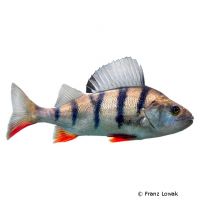European Perch (Perca fluviatilis)
| European Perch Perca fluviatilis | |
|---|---|
| Name | European Perch |
| Name Lat. | Perca fluviatilis |
| Family | Perches |
| Family lat. | Percidae |
| Order | Perch-likes |
| Order lat. | Perciformes |
| Origin | Europe, Asia |
| Habitat | Estuaries, rivers, lakes |
| Diet | Carnivore |
| pH | 7.0-7.5 |
| Behavior | Semi-aggressive |
| Keeping | Individual, pair |
| Care Level | Moderate |
| Reproduction | Substrate spawner |
| Breeding | Moderately difficult |
| Life Span | 10-15 years |
| Protection | No |
| Metric Units | |
| Size | 25 cm |
| Temperature | 4-22 °C |
| Hardness | 8-12 °dH |
| Aquarium | Ponds |
| US Units | |
| Size | 9.8" |
| Temperature | 39-72 °F |
| Hardness | 142-214 ppm |
| Aquarium | Ponds |
Distribution and habitat
River perch are widely distributed from Europe, except the Iberian Peninsula, to western Siberia and are also found in the brackish estuaries of the eastern Baltic Sea. They live in all types of stagnant waters and in small to medium-sized rivers, where they prefer to stay in the riparian zone.
Maintenance
The pond should be furnished with pond, floating and underwater plants (oxygenators) and a substrate of sand and round-grained gravel
When maintaining in a cold water aquarium (from 100 cm / 200 l), care should be taken to provide a large swimming area in addition to dense marginal planting and numerous hiding places (roots, stones). A soft substrate, oxygen-rich water and slightly shaded light (floating plants) is ideal
No ammonia, ammonium and nitrite should be detectable in the water, and the nitrate value should not exceed 100 mg/l. To ensure the water quality and oxygen content should not be missing a filter adapted to the water volume.
Diet
They are predatory fish that feed on insects, small crustaceans, fish spawn and small fish. The food supply consists of live food, such as daphnia, artemia, mysis, tubifex, mosquito larvae, etc., which is also accepted without problems in frozen form, or a commercially available frozen food mix. High-quality, protein-rich dry food is also occasionally accepted.
Only as much should be fed as is eaten in a few minutes. A regular and varied diet promotes health and increases resistance.
Behaviour and compatibility
They should be kept in pairs in the aquarium and in a group in the pond. At spawning time they behave very territorial, so keeping several pairs is recommended only in a larger and richly structured tank. They can be well socialized with other not too small fish. Basically, only compatible fish species with similar demands on water quality and water temperature should be socialized.
Reproduction and breeding
No external distinguishing characteristics are known. The males are somewhat more strongly colored at spawning time and the females appear somewhat rounder.
The spawning season extends from March to June. The female attaches her 1.5-2.5 mm eggs to the substrate (branches, plants, stones) in the form of long, net-like "perch strings". The fry hatch after 2-3 weeks and feed on plankton
Life expectancy can be up to 12 years.
Important
If used to reduce unwanted offspring of other pond fish, keep in mind that the perch themselves can reproduce heavily.
If they are overwintered in the pond, sufficient depth and oxygen supply (filter, oxygen dispenser, ice free holder) must be ensured.
At temperatures below 8-10 °C the metabolism of the sunfish slows down and no food is accepted, accordingly feeding must be stopped. If the temperature drops further, they hibernate near the bottom. In the spring, as temperatures rise, feeding can slowly resume. Feeding may also be necessary during prolonged warm periods in winter.
The well-being of the fish should be monitored regularly. Regular partial water changes are recommended, even when contaminant levels have not yet reached the upper limit. Sudden changes in water quality should be avoided. Newly introduced fish must be accustomed slowly to the water in the pond or aquarium
Further literature can be found in your pet store.
References
Text: Werner Winter; Image: Franz Lowak
Source: BMELV (1998): Tierschutzgutachten - Haltung von Zierfischen (Süßwasser); RIEHL & BAENSCH (2006): Aquarien Atlas Bd. 1, Mergus Verlag; ENGELMANN (2005): Zootierhaltung - Tiere in menschlicher Obhut: Fische, Verlag Harri Deutsch
- Gemäß § 21 Abs. 5 Tierschutzgesetz idgF
